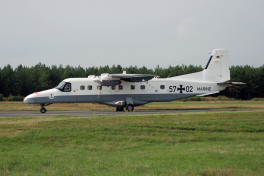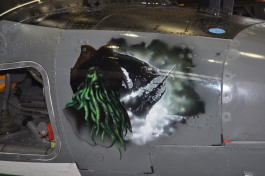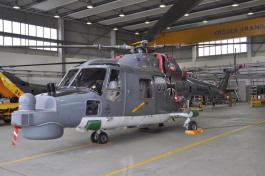|

Rolph Klijn of Karo-Aviation
reports on the new situation at Nordholz NAS
Pictures by the
author
During a visit to Nordholz
naval air station with the GRASS on,
August 25th 2014 the new organisation of the Marineflieger is reviewed .
Nordholz is situated in the north off Germany some 100 km north of
Bremen.
Since 2012 it is the only airbase left to the German Navy after the
closure of Kiel NAS
Since their establishment on 1st April
1957, five Marinefliegergeschwader (air wings) had been operational
within the German Navy, with an additional Marinefliegerlehrgruppe
(Training unit). Of these five Marinefliegergeschwader only two are
still operational at the last remaining base Nordholz.
The Marineflieger consisted out of the following five Geschwader:
- Marinefliegergeschwader 1 was the
first jet wing of the German navy operating the Seahawk from 1959.
During the years it is probably best known for the F-104 and Tornado
years in which it operated from Schleswig-Jagel until its
disbandment in 1993.
- Marinefliegergeschwader 2 has a
fairly similar history to Marinefliegergeschwader 1 operating the
same types of aircraft. The wing is properly best known for the
F-104 demo team "The Vikings" the unit was disbanded in 2005 at
Eggebek.
- Marinefliegergeschwader 3 was
established as a dedicated anti-submarine unit in 1964. Starting
with the Fairey Gannet. Via the Breguet Atlantic the unit still
operates in this role with the Lockheed P-3C Orion.
- The Marinefliegergeschwader 4 is
probably the most short-lived and little known air wing within the
German armed Forces. It was planned as a helicopter squadron in
the role of Anti-Submarine-Warfare and minesweeping. With the limited
performance of the helicopters available at the time the plan was
abandoned after a short period and the unit was disbanded at the
Island of Sylt.
- Marinefliegergeschwader 5 was
established at Kiel-Holtenau on 1st January 1958 where it would stay
until its move to Nordholz in 2012. From the start it was a
dedicated Seenotrettungsstaffel (Search And Rescue ) unit which it
stayed until the arrival of the Westland Sea king
|
|
|
|
|
|
|
|
 |
|
Dornier Do228
|
 |
|
Pirates of
the.. |
 |
|
|
Situated near the
seaport of Cuxhaven, Nordholz has a long history in aviation.
It started in 1912 as a luftschiffhafen, an airport for zeppelins. In 1913
the navy, recognizing the possibilities, moved in with their Airship
Department. It was an important zeppelin base during world war one.
According to the treaties of Versailles, all airport installations were
dismantled after the Great War in 1919. The importance of Nordholz is
highlighted by the fact, that of all 76 airships ever flown by the
imperial navy, 42 have at any time operated out of Nordholz.
Flying returned in 1938 when preparations started for the second world
war. During the war the base was used by different units. After the
second world war the American and British Air Forces used the base. In
1957 it became again a base for the German Naval Aviation Forces.
In 1959 construction of an airbase began for a third time in the history
of Nordholz. This time a single runway airfield was erected according to
NATO standards, which was to serve as a Naval Air Station. At first the
base was used by Marinefliegergeschwader 2, in 1965 the airfield was
officially handed over to Marinefliegergeschwader 3.
Today it is home to MFG3 and MFG 5, where MFG3 is flying the fixed wing
assets off the navy being the Lockheed P-3C Orion and the Dornier Do228.
And the rotary assets are combined in MFG5, flying the Westland Sea Lynx
Mk 88 and the Westland Sea King Mk 41.

The newest acquisition of the Marineflieger is the Lockheed P-3C Orion
which entered service in 2006 when eight airframes were purchased from
the Dutch navy. The Lockheed P-3C Orion was acquired as a replacement
for the Breguet Atlantic which was phased out in 2010 after more than 40
years in service.
The Lockheed P-3C Orion is used for surveillance, anti-submarine warfare
and as a flying command and control post. For this it is equipped with
radar, ESM, MAD, sonar buoys and a retractable infrared camera under the
nose. With only eight Lockheed P-3C Orionís in the squadron a spare
airframe has been acquired from the US Navy. It is not flyable but is
used for ground instruction.
At the moment the fleet of Lockheed P-3C Orion patrol aircraft is being
fitted with new wings and digital cockpit displays in a update program
to extend its lifespan and its effectivity . This update will take one
and a half year per aircraft to complete and is undertaken at Manching
in cooperation with several American partners. The aircraft are flown to
Manching at a rate of one each half year.
The Lockheed P-3C Orionís from Nordholz regularly patrol the Baltic Sea.
Keeping an eye on shipping movements. Mainly those of the Soviet Navy.
To keep boredom away, almost all of these missions get intercepted by
Sukhoi's of the Russian air force and navy. Stacking the files at the
Intel bureau on base with a nice collection of air to air pictures.
Russian fighters sometimes getting as close as a meter between wingtips.
It takes a steady hand to keep things from going wrong.
At the moment 3 airframes are at Manching, four at Nordholz and one is
in Djibouti. As part of the German contribution for operation Atalanta.
The anti-piracy mission off the coast of Somalia.
Germany is also
involved with the supply ship FGS Berlin. The ship embarks two Westland
Sea King Mk 41 helicopters from MFG5. Operation Atalanta is not the only
operation the Naval Air component is involved in.
MFG3 also operates the Dornier Do228 of which two are in service. The
Dornier Do228's are primarily used for pollution control. For this they
are equipped with radar, infrared and ultra violet camera's and multiple
sensors. Of all the missions flown about forty percent is flown at
night.
After the move from Kiel to Nordholz MFG5 operates the helicopters
element of the German navy. It already operated twenty-one Westland Sea
Kings and after its move to Nordholz the remaining twenty-two Westland
Lynxes from MFG3 were transferred to MFG5.
The Westland Sea King mk.41 was introduced into service in 1975. The
German Sea King Mk 41 was the blueprint for all SAR Sea Kings used by
RNoAF, BAF and even the No. 202 Squadron RAF. In 1987 a modernizing
program was started to give the Sea King Mk 41 a limited offensive role.
This programme included a Sea Spray MK3 Radar, Radar warning AN/ALR 68,
Chaff-/Flare M-130 and the capability for firing Sea Skua rockets was
implemented. The offensive role of the Sea King Mk 41 since returned to
Westland Sea Lynx Mk.88 with the transfer of the Sea Skua to that Unit.
Their main tasks at the moment are SAR and shipboard helicopters for the
combat supply ships such as the FGS Berlin. Still going strong but
replacement is needed.
The navy is hoping to introduce the NH90 into service in 2018 so they
can phase out the Westland Sea King Mk 41 in 2020. There is a need for
18 airframes but a decision is not yet taken although it is planned for
the beginning of 2015.
The Westland Sea Lynx
Mk 88 was introduced a little later namely in 1981 and will have to
soldier on a little longer until 2030-2035. The Westland Sea Lynx Mk 88
are used as on-board helicopter for the F122 and F123 class frigates.
The life expectancy of these ships is at least 2030 and as the NH90 is
to big the Westland Sea Lynx Mk 88 will not be phased out before the
frigates.
Since its introduction it has had 3 upgrades concerning radar, FLIR and
sonar. Keeping it operational till 2030 will probably require some
more. The usual roles are anti-submarine warfare (ASW) , anti-surface
warfare (ASuW), SAR, troop and cargo transport. For ASW, the Westland
Sea Lynx Mk 88 is equipped with a Bendix dipping sonar and torpedoes
Mk46 and Mk4A1. As ASuW becomes more important, German Sea Lynx are able
to fire Sea Skua Missiles and carry a .50 Cal. machine gun, the FN
Herstal M3M.
At the moment however the Lynx fleet has been grounded due to cracks in
the tail. The problem is taken very seriously as the cracks are so bad
they can lead to the tail breaking of.
Operated on a rental basis is a single Eurocopter EC 135. It is being
hired from a civilian company. The Eurocopter EC 135 is used for
training but also to keep up the flight hours. For instance the flying
hours on the Sea King Mk 41 are expensive and with the end of its
service life approaching the remaining flight hours are saved for
operational use. As the hours on the Eurocopter EC 135 are cheap and the
helicopter performs well it could be that in the future more of these
helicopters will be used.
The German navy is looking into the possibility of using UAV's from the
corvettes but this is only a study so far.
We would like to thank the Grass for arranging the visit and the public
affairs office at Nordholz for their support and information during that day
|